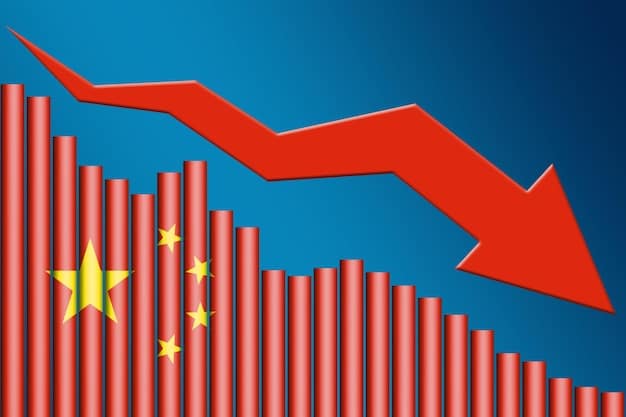China’s Economic Slowdown: Impact on US Exports Examined

China’s economic slowdown has significant implications for US exports, potentially leading to decreased demand, increased competition, and shifts in trade dynamics.
The global economy is intricately linked, and the recent slowdown in China’s economic growth is sending ripples across the world. But What are the Implications of China’s Economic Slowdown for US Exports? Understanding these implications is crucial for US businesses and policymakers.
Understanding China’s Economic Slowdown
China’s economic growth has been a driving force in the global economy for decades. However, recent years have seen a noticeable slowdown, attributed to various factors. It’s important to understand these factors to accurately assess the implications for US exports.
Several key elements are behind this shift in economic momentum.
Factors Contributing to the Slowdown
Understanding the reasons behind China’s economic deceleration helps to anticipate its effects on US exports.
- Real Estate Crisis: The troubles of major property developers have shaken confidence in the housing market, a significant pillar of the Chinese economy.
- Demographic Shifts: A declining birth rate and aging workforce are reducing the potential for future growth and straining social security systems.
- Regulatory Crackdowns: Government interventions in sectors like technology and education have created uncertainty and dampened investment.
These elements are creating a complex situation for China’s economic future.

Impact on Key US Export Sectors
The economic health of China directly influences various US industries that rely on exporting goods and services to the Chinese market. Here’s a breakdown of how specific sectors may be affected.
Different sectors are affected in different ways.
Agriculture
China is a major importer of US agricultural products, including soybeans, corn, and meat. A slowdown could lead to decreased demand for these goods.
Technology
US tech companies export a wide range of products and services to China. Reduced consumer spending and investment in China could hurt sales of these products.
Manufacturing
China is a key market for US manufactured goods, including machinery and equipment. A slowdown could negatively impact US manufacturing exports.
Analyzing these impacts is key to understanding how the slowdown will influence US exports.
Potential for Decreased Demand
One of the primary concerns for US exporters is the potential for decreased demand from China. Slower economic growth can translate into reduced consumer spending and business investment, impacting the volume of goods and services imported.
Decreased Demand is a major concern.
The implications of this reduced demand extend beyond individual companies, affecting the overall trade balance between the US and China.
- Reduced Export Volumes: US companies may face lower sales volumes to China, impacting revenue and profits.
- Inventory Buildup: Companies may experience increased inventory levels due to decreased demand, leading to increased storage costs.
- Price Pressures: US exporters may be forced to lower prices to remain competitive in the Chinese market, reducing profit margins.
These issues must be faced strategically to mitigate adverse effects.
Increased Competition in the Chinese Market
As China’s economy slows, domestic companies may face increased pressure to compete for a smaller pool of customers. This could intensify competition for US exporters operating in the Chinese market.
Competition is likely to increase.
The shift towards prioritizing domestic consumption within China, combined with government support for local industries, could further disadvantage US exporters.
- Price Wars: Chinese companies may engage in price wars to gain market share, making it difficult for US exporters to compete on price.
- Increased Protectionism: The Chinese government may implement policies to protect domestic industries, creating barriers for US exports.
- Innovation and Adaptation: US companies will need to innovate and adapt their products and services to meet the changing needs of the Chinese market.
Keeping up with the Chinese market and all of its intricacies is essential.

Shifts in Trade Dynamics and Strategies
The slowdown in China’s economy could prompt shifts in global trade dynamics and require US exporters to re-evaluate their strategies.
Strategies might have to change.
Diversifying export markets, enhancing competitiveness, and adapting to evolving consumer preferences will be crucial for US companies to navigate the changing landscape.
Diversification of Export Markets
Reducing reliance on the Chinese market by exploring and expanding into other markets in Asia, Europe, and Latin America.
Enhancing Competitiveness
Investing in research and development, improving product quality, and streamlining operations to reduce costs and enhance competitiveness.
Adapting to Evolving Consumer Preferences
Conducting market research to understand changing consumer preferences in China and adapting products and services accordingly.
These adaptations should help to succeed in an ever-changing environment.
Navigating Uncertainty and Risk Management
Given the uncertainty surrounding China’s economic outlook, effective risk management strategies are essential for US exporters. This includes assessing potential risks, implementing mitigation measures, and developing contingency plans.
Risk must be managed effectively.
Staying informed about economic developments in China, monitoring government policies, and seeking expert advice will be crucial for navigating the evolving landscape.
- Economic Monitoring: Closely monitoring key economic indicators in China, such as GDP growth, inflation, and unemployment rates.
- Policy Awareness: Keeping abreast of changes in government policies and regulations that could impact US exports.
- Expert Consultation: Seeking advice from trade experts, economists, and consultants to better understand the risks and opportunities in the Chinese market.
These steps help to ensure as smooth a transition as possible.
| Key Point | Brief Description |
|---|---|
| 📉 Decreased Demand | Slower growth in China may reduce demand for US exports. |
| ⚔️ Increased Competition | US exporters may face more competition from Chinese firms. |
| 🌐 Trade Shifts | US exporters may need to diversify into other markets. |
| ⚠️ Risk Management | Effective risk management is vital due to China’s uncertain outlook. |
Frequently Asked Questions
China is a major importer of US agricultural products. A slowdown could lead to reduced demand for soybeans, corn, and meat, impacting US farmers’ income and export volumes.
Diversifying export markets, enhancing competitiveness through innovation, and adapting products to meet evolving consumer preferences in China are essential strategies for US exporters.
Increased competition from domestic Chinese companies could lead to price wars and pressure on US exporters’ profit margins. Adaptability and unique value propositions are vital for survival.
Government policies in China, such as increased protectionism or support for local industries, can significantly impact US exports by creating barriers or favoring domestic companies over foreign competitors.
US exporters should closely monitor China’s GDP growth, inflation rates, consumer spending trends, and any policy changes that could affect trade relations to proactively respond to changing conditions.
Conclusion
In conclusion, China’s economic slowdown presents both challenges and opportunities for US exporters. While decreased demand and increased competition pose risks, proactive strategies such as diversification, innovation, and adaptability can help US companies navigate the changing landscape and maintain a strong presence in the global market.





